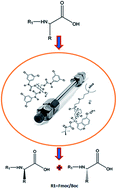Development of novel enantioselective HPLC methods for the determination of the optical purity of Nα-Fmoc/Boc amino acid derivatives (Nα-PADs) of natural and unnatural amino acids: an analytical strategy for the key starting materials of therapeutic peptides
Abstract
Control of the chiral purity of Nα-Fmoc/Boc amino acid derivatives (Nα-PADs) used in the manufacturing of therapeutic peptides is an important material quality attribute to reduce the risk of undesired pharmacological and toxicological effects arising from related diastereomeric impurities in drug substances. In this study, chiral HPLC methods for 4 pairs of unnatural (Tic, Oic, Ala(thi) and Hyp) and 11 pairs of natural Nα-Fmoc amino acid derivatives (Nα-PADs) were developed and optimized on carbohydrate-based chiral stationary phases (CSPs) – CHIRALPAK IA, IC and QNAX. Mobile phase solvent polarity played a major role in chiral recognition events using CSPs, among the other method parameters such as temperature, flow rate and mobile phase additives. CHIRALPAK IA, IC and QNAX were able to show chiral recognition for all the D and L enantiomers of 4 unnatural (Tic, Oic, Ala(thi) and Hyp) Nα-PADs, with better selectivity (1.32 < α < 2.12) and resolution (2.9 < Rs < 7.7) towards the IC CSP. Natural Nα-PADs also showed better selectivity (1.18 < α < 2.88) and resolution (2.2 < Rs < 12.5) on the IC CSP compared to the QNAX CSP (1.02 < α < 1.59) and (1.6 < Rs < 6.0), respectively. Enantiomeric recognition of Phe Nα-PADs was higher towards CHIRALPAK IA (1.64 < α < 2.67; 7.41 < Rs < 8.62) compared to CHIRALPAK IC and QNAX CSPs. Considering the trends of hydrophobicity (log P) of Nα-PADs and obtained separation factors (α), chiral recognition especially on CHIRALPAK IC is primarily influenced by the hydrophobicity (π–π interactions) arising due to the protecting groups when analysed under similar mobile phase solvent mixtures and chromatographic conditions. The recognition events on QNAX can be due to ion exchange and dipole–dipole interactions evident from lower retention times for both natural and unnatural Nα-PADs. These optimized methods were further validated as per ICH guidelines and sensitive in estimating undesired isomers (≤0.05%) in the presence of desired isomers.



 Please wait while we load your content...
Please wait while we load your content...